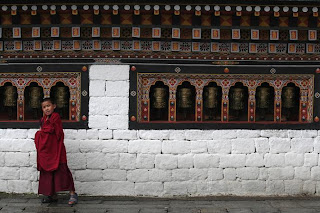
Seeing a few different monasteries in Bhutan has helped me get a pretty good feel for what they're all about. At all the monasteries I've seen so far the construction and artwork has been somewhat similar. Prayer wheels, painted woodwork, butter lamps, colorful ritual cakes, murals, hardwood floors, gold-painted figures, bowls of holy water, and decorative cloths hanging from the ceiling have all been constants at the monasteries I've been to. I'm sure that all of those things are typical of the Bhutanese culture. The Tiger's Nest was easily the most distinctive of the monestaries I've seen and I'm glad that was one of the first ones I went to. It felt that much more exotic because it was all new to me. A monk led Tenzin and I through the different temples of Cheri monestary and Tenzin described to me the meaning behind many of the shrines and paintings and decorations. Afterwards I had Tenzin snap a picture of me with the monk, and we headed back down the hill to meet Gudu at the bottom. 

Back in Thimpu I spent about a half-hour visiting the Folk Heritage Museum. Tenzin relaxed outside for a few minutes while a young guide at the museum led me through an authentic Bhutanese farm house. The house was used as recently as 2001, when the Bhutan government converted it to a museum. I passed through hay-filled stables on the lower level and bedrooms and a game room on the upper levels. On the top level was a room with a Buddhist shrine. According to the guide, every house in Bhutan has a shrine where the residents of the household bow and worship every morning.
Every lunch and dinner I've had in Bhutan so far has been so lavish. Normally I wouldn't eat nearly this well while traveling, but because of the minimum daily spending amount imposed by the government, I have no other option except to eat extravagant meals at least twice a day. Today the polite staff at Eight Brother's Restaurant in Thimpu brought me roasted potatoes with garlic sauce, dumplings filled with cheese, sliced pork with chilis, beef with chilis and a thin cheese sauce, mixed vegetables, and a giant bowl of steamed rice. Tomorrow in Kathmandu I'll be back to eating a cheap bowl of noodles and maybe a bread roll once or twice a day.
The highlight of the day was a visit to Thimpu's massive dzong. The name of the dzong, Tashichhodzong, translates to “fortress of the auspicious religion”. I'm assuming that the auspicious religion they're referring to would be Buddhism. Tashichhodzong is about twice the size of Paro Dzong, the fortress I visited on my first day in Bhutan. I spent about an hour just hanging around in the stone courtyard of the dzong, watching monks walk back and forth in front of a long row of prayer wheels. I enjoyed just wandering around in a light drizzle of rain and taking a few photos that I hope will do the place justice. 
Saturday, June 14, 2008
Tashichhodzong
Subscribe to:
Post Comments (Atom)







1 comments:
Michael: I love your blog! You have finally gone somewhere that Grandma Calder not only has not visited, but was not familiar with! She is coming to dinner today and I am going to let her read your blog on my laptop as she sits in the garden for supper. Grandma and Grandpa Spendlove will also be there for a Father's Day dinner. Much love, Mom
Post a Comment